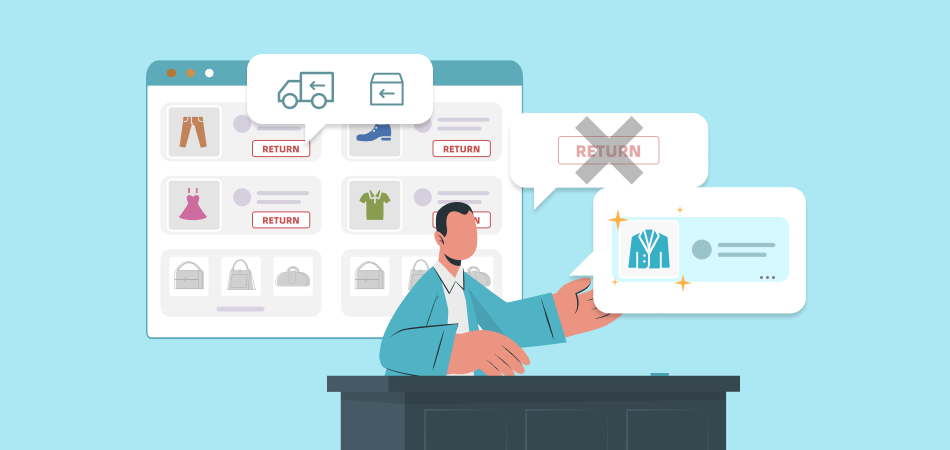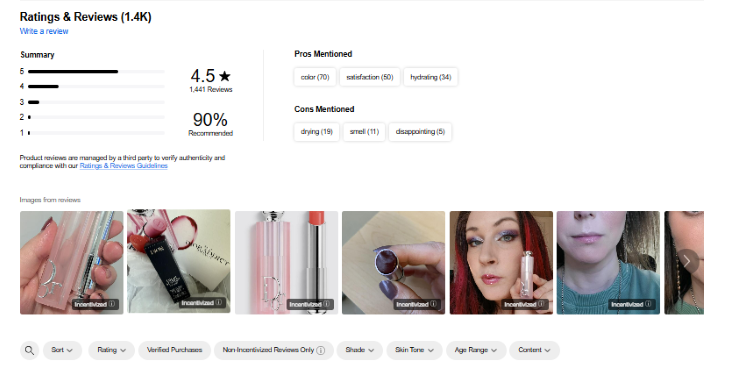How to Reduce Returns in Ecommerce: 11 Practical Ways 2025

If you run an e-commerce business, you know that product returns can eat into your profits, drain your time, and impact your customer satisfaction. Whether you’re shipping physical products directly or operating a dropshipping store, return rates are a challenge nearly every seller faces.
So, how to reduce returns in e-commerce? We’ll explore 11 practical, proven ways to reduce e-commerce returns, followed by specific tips for dropshippers managing third-party fulfillment.
11 Essential Ways to Avoid Returns for Your E-commerce Business
Every return tells a story. Maybe a customer received the wrong size, didn’t understand the product features, or simply felt the item didn’t match the photos. Whatever the reason, many returns can be prevented by improving clarity, accuracy, and the overall post-purchase experience.
Let’s walk through 11 strategies you can implement right away to cut down on return rates and increase repeat business while you’re at it.
1. Write Clear, Detailed Product Descriptions
Your product description is the closest thing a customer gets to “picking up the product” before they buy it. The more specific, accurate, and transparent your description is, the less room there is for misunderstandings.
Include key specs like:
- Dimensions and weight
- Materials or ingredients
- Use cases and limitations
- Care instructions

Avoid overhyping and be honest about your product. A real and detailed product description can reduce the return rate of goods effectively.
2. Use High-Quality, Accurate Product Images
Photos can make or break a product listing. Low-resolution images or overly edited photos lead to confusion and disappointment. Use multiple angles, include close-ups, and showcase different product variations.
Better yet, include lifestyle shots—real people using your product in everyday settings. This helps set expectations and gives customers a realistic sense of scale, color, and functionality.
3. Add Sizing Charts and Fit Guides
This is particularly necessary for fashion, footwear, and wearable items. A vague “runs small” review won’t cut it. Include clear sizing charts, and if possible, create guides that compare your sizes to standard US, UK, and EU sizing.
Go further by offering fit advice: is the item slim, relaxed, or oversized? You can even include model photos with height and size details to give a sense of proportion.
4. Encourage Customer Reviews and Photos
User-generated content is a powerful trust builder, and it’s also one of the best tools to prevent returns. Real reviews help customers gauge if a product is right for them, while photos show how the item looks outside a studio setting.
Encourage reviews with:
- Post-purchase follow-up emails
- Loyalty points or discounts
- Gentle reminders or pop-ups

Display them prominently on product pages. By showcasing reviews, ratings, and testimonials, you provide potential buyers with social proof that can influence their purchasing decisions. It helps build trust, as customers can see real feedback from others who have used the product.
5. Offer Live Chat or Pre-Sale Support
Sometimes a return happens simply because the buyer had a question they didn’t get answered before clicking “buy.” Offering live chat, AI chatbots, or even a support phone number during checkout can reduce buyer hesitation and prevent mismatched purchases.
Train your customer service team to ask helpful pre-sale questions like:
- “What are you planning to use the product for?”
- “Do you prefer a tight or loose fit?”
- “Is this a gift or for personal use?”
Proactive support helps alleviate buyer uncertainty, fostering greater confidence in their purchasing decisions. You create a supportive shopping environment by addressing potential questions or concerns before they arise.
6. Show Return Policies Clearly (But Smartly)
While it might seem counterintuitive, showing your return policy clearly reduces return rates because it builds trust. That said, how you communicate your policy matters.
Return policy links should be near your "Add to Cart" buttons and in your FAQs. Use reassuring language.
- “We’re happy to help with returns within 30 days if the item isn’t what you expected.”
- At the same time, use policy design to discourage casual returns:
- Products must remain unopened and retain their original packaging.
- Don't offer “free returns for any reason” unless it is financially viable and strategically beneficial for your business.
- Encourage store credit over refunds
- Clarity deters abuse and ensures customers think before buying.
7. Automate Post-Purchase Updates
A significant portion of product returns occurs not due to issues with the products themselves, but rather because of shipping delays or miscommunication.
When customers do not receive their orders on time or face confusion about delivery details, it can lead to frustration and dissatisfaction, which results in returns. You could send automatic post-purchase emails that:
- Confirm the order and estimated delivery
- Share tracking numbers
- Set realistic delivery expectations
- Include usage guides or “how to care for your item” info

|
Tracking Number with Auto Sync Auto Sync Tracking Numbers - Automatically sync the tracking number from AliExpress to your store |
Customers who feel informed and supported are less likely to become frustrated or request a return prematurely.
8. Use Branded Packaging and Instructions
Unboxing is more than a social media trend, it’s part of the customer experience. Products that arrive in messy, confusing, or cheap packaging are more likely to be returned.
Instead, create packaging that:
- Protects the product well
- Reinforces your brand identity
- Includes helpful inserts (instructions, tips, contact info)
Well-presented items make customers feel like they’re buying from a trustworthy business, and they’re more likely to give the product a real shot before returning.
9. Offer Product Bundles or Upsells Wisely
Bundling products with a perceived discount can enhance the average order value by motivating customers to purchase more items.
However, this strategy can backfire if customers feel pressured to buy multiple items that they do not truly want or need.
So, you should use product bundles smartly by:
- Offering mix-and-match options
- Including flexible return terms (e.g., partial returns allowed)
- Providing clear descriptions for each item in the bundle

|
Place Orders to AliExpress In Seconds DSers Bulk Order - Place 100s of orders to AliExpress in a few seconds with a just few clicks |
When done right, bundles reduce returns because customers feel they’ve received a better deal and are more invested in keeping the items.
10. Monitor Return Reasons and Spot Patterns
Returns can be a valuable source of insight if leveraged correctly. Rather than viewing them solely as a problem, businesses should treat returns as an opportunity to learn and improve. By tracking the reasons behind returns, you can gather critical data that helps identify patterns and areas for improvement.
If you notice patterns like:
- “Runs smaller than expected”
- “Color doesn’t match photo”
- “Not as described”
…then it’s time to make updates to your listings, suppliers, or support scripts.
Identifying repeat problems in the returns process is essential for proactively addressing issues before they lead to future returns. Businesses can take corrective actions that enhance product quality and customer experience.
11. Improve Product Quality Over Time
Finally, there’s no shortcut around product quality. If customers are returning items because of defects, poor materials, or usability problems, no amount of clever copy or good packaging can fix it. Cooperate with your manufacturers or suppliers to:
- Get samples before listing
- Run periodic quality checks
- Replace underperforming SKUs
The better your products, the lower your return rate as simple as that. With good product quality, businesses can create a more positive customer experience, ultimately resulting in lower return rates and increased customer loyalty.
How to Reduce Returns as a Dropshipper
As a dropshipper, you face unique challenges when it comes to returns. Since you don’t physically handle the inventory, and you rely on third-party suppliers (often international), your control over fulfillment and product quality can be limited.
But that doesn’t mean you’re helpless. Many successful dropshippers have found smart ways to minimize returns, even without holding inventory.
Here’s how to reduce returns in dropshipping more effectively:
1. Vet Suppliers Carefully
Your return rate is directly tied to the reliability of your suppliers. Work only with high-rated AliExpress or wholesale vendors who have consistent shipping, solid product ratings, and verified order volumes.

|
Find Better Supplier For Products DSers Supplier Optimizer - One click to filter out the most proper suppliers for your products |
If you use DSers or a similar app, take advantage of features like the Supplier Optimizer to compare and switch to vendors with lower return histories or better reviews.
2. Order Samples Before Selling
Don’t just trust product listings. Order samples yourself before you start selling an item. Samples help you improve the overall quality of your listings, enhance customer satisfaction, and ultimately reduce return rates.
Sample ordering can help you:
- Assess quality and packaging
- Take your own photos
- Write more accurate descriptions
- Test delivery times
You’ll also be more confident answering customer questions and preventing mismatched expectations that lead to refunds. It demonstrates a commitment to quality and customer care, which can distinguish your brand in the marketplace.
3. Set Realistic Delivery Times
AliExpress shipping can take 2–4 weeks, even longer during holidays. Be upfront about this on your product pages. If customers think their item will arrive in 5 days and it takes 20, expect complaints, even if the product is perfect.
Use clear delivery messaging like:
- “Shipping time: 12–20 business days, depending on location. The tracking info is sent as soon as items ship.”
- Transparency reduces cancellations, chargebacks, and returns.
4. Create a Dropshipping-Friendly Return Policy
International returns can indeed be costly and logistically challenging, especially for dropshippers. To mitigate these issues, many businesses adopt flexible return policies that balance customer satisfaction with operational efficiency. Here are some common strategies
- Store credit instead of cash refunds
- Partial refunds without return
- “Keep the item” refunds for low-cost products
Set your policy up front and explain it clearly at checkout. You can protect your margins while still providing a positive shopping experience, ultimately fostering customer loyalty and reducing the likelihood of returns.
5. Use DSers to Track Orders and Handle Refunds
Tools like DSers can significantly streamline dropshipping by automating several key functions. The following are the benefits of these functions.
- Tracking sync to customers
- Order management
- Fast dispute handling with AliExpress sellers

|
Tracking Number with Auto Sync Auto Sync Tracking Numbers - Automatically sync the tracking number from AliExpress to your store |
This helps you quickly verify claims and request refunds or replacements without wasting hours of manual work. Customers who see fast responses are more likely to remain loyal even if the order didn’t go perfectly.
Conclusion
Returns are a fact of life in e-commerce, but they don’t have to drain your business constantly. With the right combination of clear communication, strong product presentation, proactive support, and smart logistics, you can significantly reduce your returns in e-commerce while building stronger relationships with your customers.
For dropshippers, the key lies in choosing reliable suppliers, setting realistic expectations, and using tools like DSers to stay ahead of issues before they become refund requests.











 Company
Company
 Why Choose DSers
Why Choose DSers
 Blog
Blog
 Help Center
Help Center




 Live Chat
Live Chat